Hyperdrive Innovation: Building a Sustainable Lithium-Ion System
VerifiedAdded on 2023/06/10
|13
|3592
|245
Report
AI Summary
This report provides a comprehensive analysis of the circular economy practices related to lithium-ion batteries, focusing on Hyperdrive Innovation. It details the materials used in lithium-ion batteries, their suitability for a circular economy, and the existing product lifecycle stages, including extraction, deployment, and end-of-life. The report also describes a future industrial system and lifecycle stages, emphasizing waste hierarchy and the potential for a sustainable future. Furthermore, it outlines a 10-year strategy for Hyperdrive Innovation to build a sustainable system by focusing on raw material extraction, reducing supply chain risks, and implementing effective battery management systems to ensure safety, performance, and longevity. The analysis indicates that while recycling lithium-ion batteries is complex, the materials used are largely sustainable due to their recyclability and reduced environmental impact, aligning with circular economy principles.
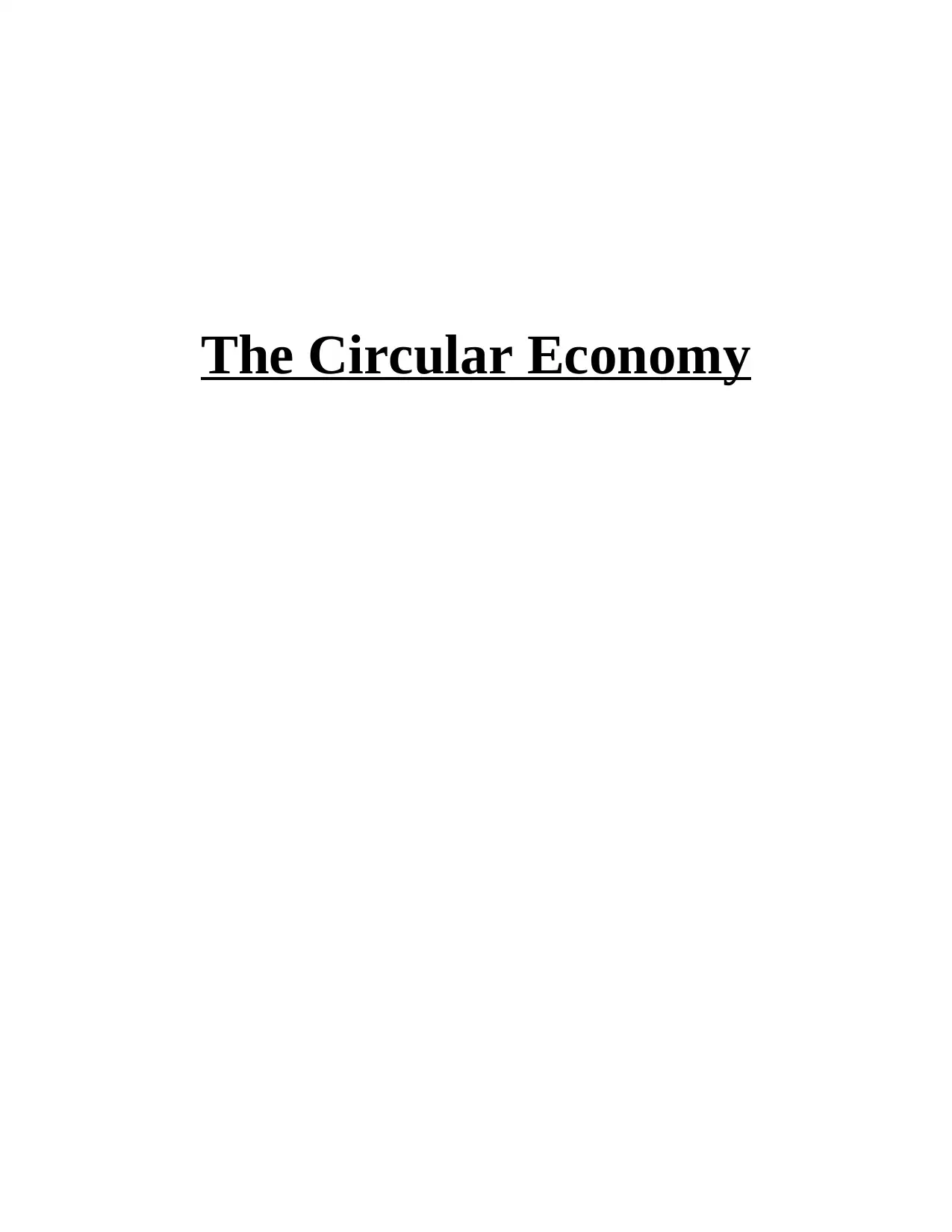
The Circular Economy
Paraphrase This Document
Need a fresh take? Get an instant paraphrase of this document with our AI Paraphraser
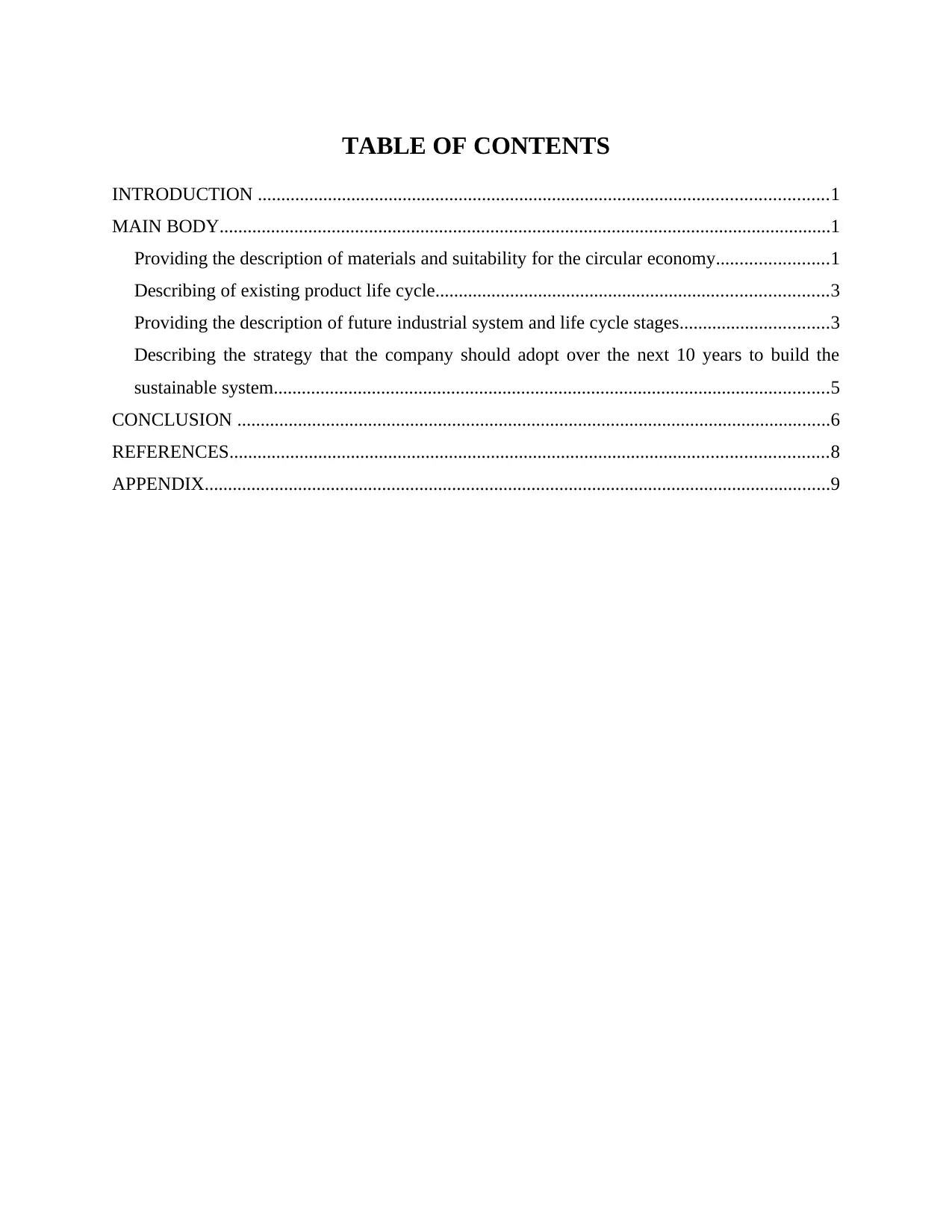
TABLE OF CONTENTS
INTRODUCTION ..........................................................................................................................1
MAIN BODY...................................................................................................................................1
Providing the description of materials and suitability for the circular economy........................1
Describing of existing product life cycle....................................................................................3
Providing the description of future industrial system and life cycle stages................................3
Describing the strategy that the company should adopt over the next 10 years to build the
sustainable system.......................................................................................................................5
CONCLUSION ...............................................................................................................................6
REFERENCES................................................................................................................................8
APPENDIX......................................................................................................................................9
INTRODUCTION ..........................................................................................................................1
MAIN BODY...................................................................................................................................1
Providing the description of materials and suitability for the circular economy........................1
Describing of existing product life cycle....................................................................................3
Providing the description of future industrial system and life cycle stages................................3
Describing the strategy that the company should adopt over the next 10 years to build the
sustainable system.......................................................................................................................5
CONCLUSION ...............................................................................................................................6
REFERENCES................................................................................................................................8
APPENDIX......................................................................................................................................9
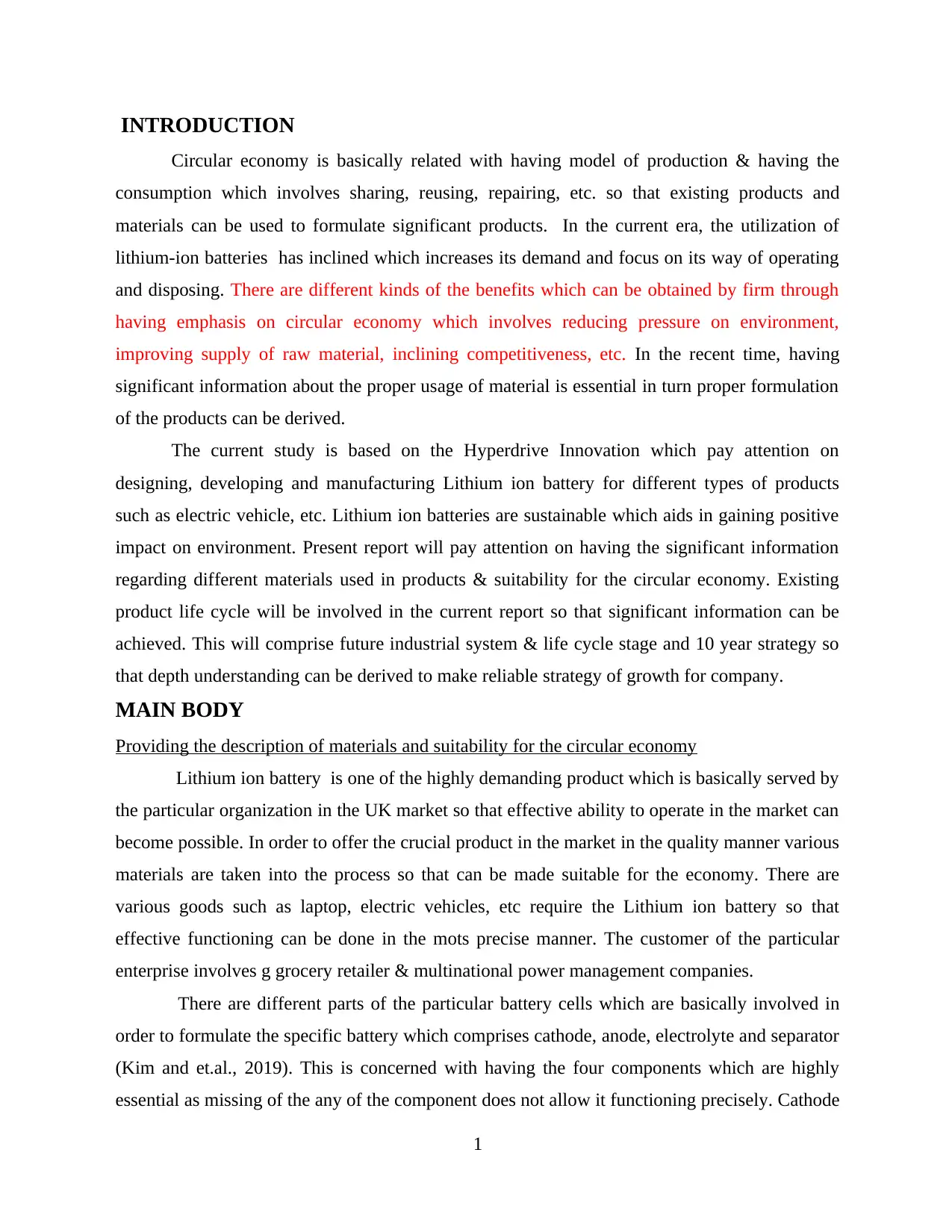
INTRODUCTION
Circular economy is basically related with having model of production & having the
consumption which involves sharing, reusing, repairing, etc. so that existing products and
materials can be used to formulate significant products. In the current era, the utilization of
lithium-ion batteries has inclined which increases its demand and focus on its way of operating
and disposing. There are different kinds of the benefits which can be obtained by firm through
having emphasis on circular economy which involves reducing pressure on environment,
improving supply of raw material, inclining competitiveness, etc. In the recent time, having
significant information about the proper usage of material is essential in turn proper formulation
of the products can be derived.
The current study is based on the Hyperdrive Innovation which pay attention on
designing, developing and manufacturing Lithium ion battery for different types of products
such as electric vehicle, etc. Lithium ion batteries are sustainable which aids in gaining positive
impact on environment. Present report will pay attention on having the significant information
regarding different materials used in products & suitability for the circular economy. Existing
product life cycle will be involved in the current report so that significant information can be
achieved. This will comprise future industrial system & life cycle stage and 10 year strategy so
that depth understanding can be derived to make reliable strategy of growth for company.
MAIN BODY
Providing the description of materials and suitability for the circular economy
Lithium ion battery is one of the highly demanding product which is basically served by
the particular organization in the UK market so that effective ability to operate in the market can
become possible. In order to offer the crucial product in the market in the quality manner various
materials are taken into the process so that can be made suitable for the economy. There are
various goods such as laptop, electric vehicles, etc require the Lithium ion battery so that
effective functioning can be done in the mots precise manner. The customer of the particular
enterprise involves g grocery retailer & multinational power management companies.
There are different parts of the particular battery cells which are basically involved in
order to formulate the specific battery which comprises cathode, anode, electrolyte and separator
(Kim and et.al., 2019). This is concerned with having the four components which are highly
essential as missing of the any of the component does not allow it functioning precisely. Cathode
1
Circular economy is basically related with having model of production & having the
consumption which involves sharing, reusing, repairing, etc. so that existing products and
materials can be used to formulate significant products. In the current era, the utilization of
lithium-ion batteries has inclined which increases its demand and focus on its way of operating
and disposing. There are different kinds of the benefits which can be obtained by firm through
having emphasis on circular economy which involves reducing pressure on environment,
improving supply of raw material, inclining competitiveness, etc. In the recent time, having
significant information about the proper usage of material is essential in turn proper formulation
of the products can be derived.
The current study is based on the Hyperdrive Innovation which pay attention on
designing, developing and manufacturing Lithium ion battery for different types of products
such as electric vehicle, etc. Lithium ion batteries are sustainable which aids in gaining positive
impact on environment. Present report will pay attention on having the significant information
regarding different materials used in products & suitability for the circular economy. Existing
product life cycle will be involved in the current report so that significant information can be
achieved. This will comprise future industrial system & life cycle stage and 10 year strategy so
that depth understanding can be derived to make reliable strategy of growth for company.
MAIN BODY
Providing the description of materials and suitability for the circular economy
Lithium ion battery is one of the highly demanding product which is basically served by
the particular organization in the UK market so that effective ability to operate in the market can
become possible. In order to offer the crucial product in the market in the quality manner various
materials are taken into the process so that can be made suitable for the economy. There are
various goods such as laptop, electric vehicles, etc require the Lithium ion battery so that
effective functioning can be done in the mots precise manner. The customer of the particular
enterprise involves g grocery retailer & multinational power management companies.
There are different parts of the particular battery cells which are basically involved in
order to formulate the specific battery which comprises cathode, anode, electrolyte and separator
(Kim and et.al., 2019). This is concerned with having the four components which are highly
essential as missing of the any of the component does not allow it functioning precisely. Cathode
1
⊘ This is a preview!⊘
Do you want full access?
Subscribe today to unlock all pages.

Trusted by 1+ million students worldwide
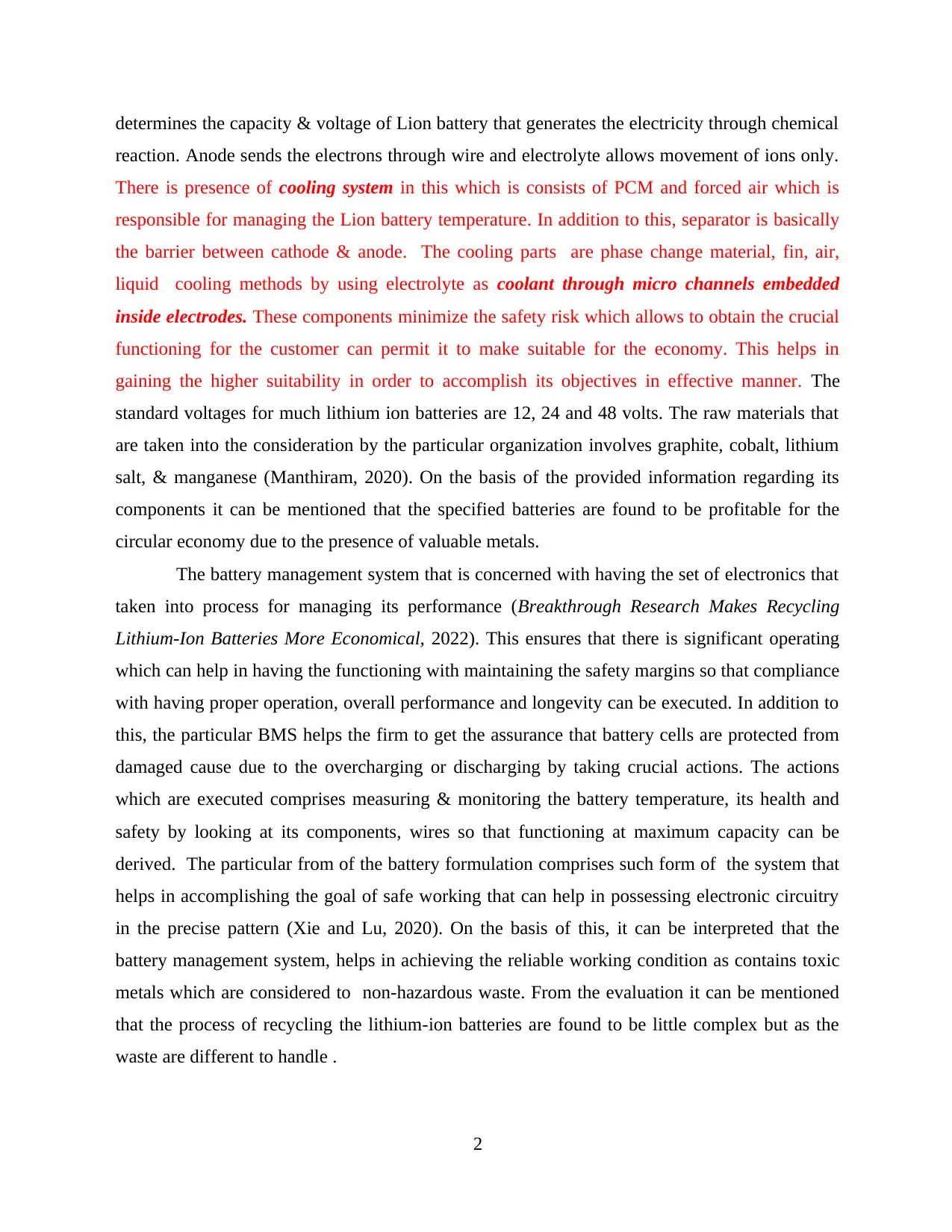
determines the capacity & voltage of Lion battery that generates the electricity through chemical
reaction. Anode sends the electrons through wire and electrolyte allows movement of ions only.
There is presence of cooling system in this which is consists of PCM and forced air which is
responsible for managing the Lion battery temperature. In addition to this, separator is basically
the barrier between cathode & anode. The cooling parts are phase change material, fin, air,
liquid cooling methods by using electrolyte as coolant through micro channels embedded
inside electrodes. These components minimize the safety risk which allows to obtain the crucial
functioning for the customer can permit it to make suitable for the economy. This helps in
gaining the higher suitability in order to accomplish its objectives in effective manner. The
standard voltages for much lithium ion batteries are 12, 24 and 48 volts. The raw materials that
are taken into the consideration by the particular organization involves graphite, cobalt, lithium
salt, & manganese (Manthiram, 2020). On the basis of the provided information regarding its
components it can be mentioned that the specified batteries are found to be profitable for the
circular economy due to the presence of valuable metals.
The battery management system that is concerned with having the set of electronics that
taken into process for managing its performance (Breakthrough Research Makes Recycling
Lithium-Ion Batteries More Economical, 2022). This ensures that there is significant operating
which can help in having the functioning with maintaining the safety margins so that compliance
with having proper operation, overall performance and longevity can be executed. In addition to
this, the particular BMS helps the firm to get the assurance that battery cells are protected from
damaged cause due to the overcharging or discharging by taking crucial actions. The actions
which are executed comprises measuring & monitoring the battery temperature, its health and
safety by looking at its components, wires so that functioning at maximum capacity can be
derived. The particular from of the battery formulation comprises such form of the system that
helps in accomplishing the goal of safe working that can help in possessing electronic circuitry
in the precise pattern (Xie and Lu, 2020). On the basis of this, it can be interpreted that the
battery management system, helps in achieving the reliable working condition as contains toxic
metals which are considered to non-hazardous waste. From the evaluation it can be mentioned
that the process of recycling the lithium-ion batteries are found to be little complex but as the
waste are different to handle .
2
reaction. Anode sends the electrons through wire and electrolyte allows movement of ions only.
There is presence of cooling system in this which is consists of PCM and forced air which is
responsible for managing the Lion battery temperature. In addition to this, separator is basically
the barrier between cathode & anode. The cooling parts are phase change material, fin, air,
liquid cooling methods by using electrolyte as coolant through micro channels embedded
inside electrodes. These components minimize the safety risk which allows to obtain the crucial
functioning for the customer can permit it to make suitable for the economy. This helps in
gaining the higher suitability in order to accomplish its objectives in effective manner. The
standard voltages for much lithium ion batteries are 12, 24 and 48 volts. The raw materials that
are taken into the consideration by the particular organization involves graphite, cobalt, lithium
salt, & manganese (Manthiram, 2020). On the basis of the provided information regarding its
components it can be mentioned that the specified batteries are found to be profitable for the
circular economy due to the presence of valuable metals.
The battery management system that is concerned with having the set of electronics that
taken into process for managing its performance (Breakthrough Research Makes Recycling
Lithium-Ion Batteries More Economical, 2022). This ensures that there is significant operating
which can help in having the functioning with maintaining the safety margins so that compliance
with having proper operation, overall performance and longevity can be executed. In addition to
this, the particular BMS helps the firm to get the assurance that battery cells are protected from
damaged cause due to the overcharging or discharging by taking crucial actions. The actions
which are executed comprises measuring & monitoring the battery temperature, its health and
safety by looking at its components, wires so that functioning at maximum capacity can be
derived. The particular from of the battery formulation comprises such form of the system that
helps in accomplishing the goal of safe working that can help in possessing electronic circuitry
in the precise pattern (Xie and Lu, 2020). On the basis of this, it can be interpreted that the
battery management system, helps in achieving the reliable working condition as contains toxic
metals which are considered to non-hazardous waste. From the evaluation it can be mentioned
that the process of recycling the lithium-ion batteries are found to be little complex but as the
waste are different to handle .
2
Paraphrase This Document
Need a fresh take? Get an instant paraphrase of this document with our AI Paraphraser
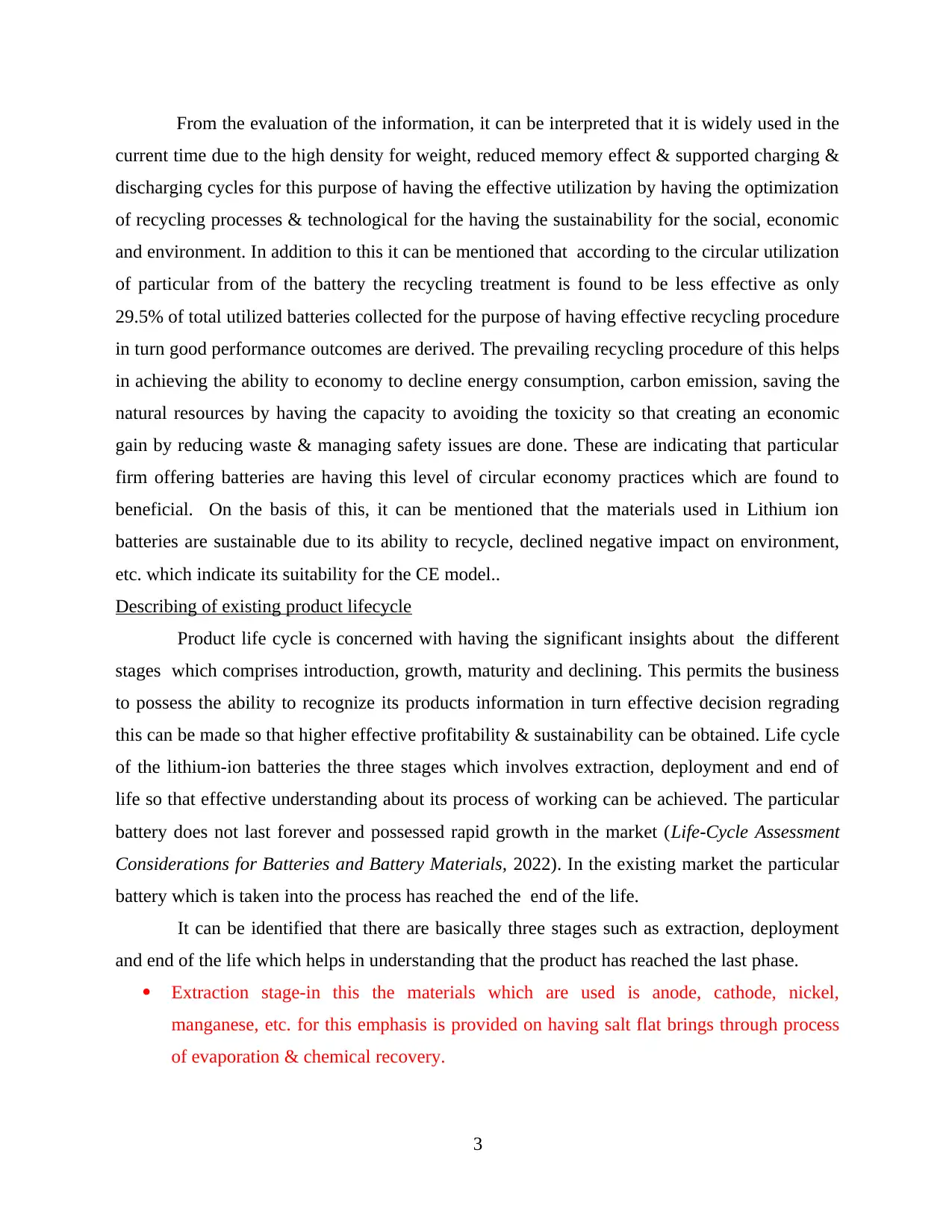
From the evaluation of the information, it can be interpreted that it is widely used in the
current time due to the high density for weight, reduced memory effect & supported charging &
discharging cycles for this purpose of having the effective utilization by having the optimization
of recycling processes & technological for the having the sustainability for the social, economic
and environment. In addition to this it can be mentioned that according to the circular utilization
of particular from of the battery the recycling treatment is found to be less effective as only
29.5% of total utilized batteries collected for the purpose of having effective recycling procedure
in turn good performance outcomes are derived. The prevailing recycling procedure of this helps
in achieving the ability to economy to decline energy consumption, carbon emission, saving the
natural resources by having the capacity to avoiding the toxicity so that creating an economic
gain by reducing waste & managing safety issues are done. These are indicating that particular
firm offering batteries are having this level of circular economy practices which are found to
beneficial. On the basis of this, it can be mentioned that the materials used in Lithium ion
batteries are sustainable due to its ability to recycle, declined negative impact on environment,
etc. which indicate its suitability for the CE model..
Describing of existing product lifecycle
Product life cycle is concerned with having the significant insights about the different
stages which comprises introduction, growth, maturity and declining. This permits the business
to possess the ability to recognize its products information in turn effective decision regrading
this can be made so that higher effective profitability & sustainability can be obtained. Life cycle
of the lithium-ion batteries the three stages which involves extraction, deployment and end of
life so that effective understanding about its process of working can be achieved. The particular
battery does not last forever and possessed rapid growth in the market (Life-Cycle Assessment
Considerations for Batteries and Battery Materials, 2022). In the existing market the particular
battery which is taken into the process has reached the end of the life.
It can be identified that there are basically three stages such as extraction, deployment
and end of the life which helps in understanding that the product has reached the last phase.
Extraction stage-in this the materials which are used is anode, cathode, nickel,
manganese, etc. for this emphasis is provided on having salt flat brings through process
of evaporation & chemical recovery.
3
current time due to the high density for weight, reduced memory effect & supported charging &
discharging cycles for this purpose of having the effective utilization by having the optimization
of recycling processes & technological for the having the sustainability for the social, economic
and environment. In addition to this it can be mentioned that according to the circular utilization
of particular from of the battery the recycling treatment is found to be less effective as only
29.5% of total utilized batteries collected for the purpose of having effective recycling procedure
in turn good performance outcomes are derived. The prevailing recycling procedure of this helps
in achieving the ability to economy to decline energy consumption, carbon emission, saving the
natural resources by having the capacity to avoiding the toxicity so that creating an economic
gain by reducing waste & managing safety issues are done. These are indicating that particular
firm offering batteries are having this level of circular economy practices which are found to
beneficial. On the basis of this, it can be mentioned that the materials used in Lithium ion
batteries are sustainable due to its ability to recycle, declined negative impact on environment,
etc. which indicate its suitability for the CE model..
Describing of existing product lifecycle
Product life cycle is concerned with having the significant insights about the different
stages which comprises introduction, growth, maturity and declining. This permits the business
to possess the ability to recognize its products information in turn effective decision regrading
this can be made so that higher effective profitability & sustainability can be obtained. Life cycle
of the lithium-ion batteries the three stages which involves extraction, deployment and end of
life so that effective understanding about its process of working can be achieved. The particular
battery does not last forever and possessed rapid growth in the market (Life-Cycle Assessment
Considerations for Batteries and Battery Materials, 2022). In the existing market the particular
battery which is taken into the process has reached the end of the life.
It can be identified that there are basically three stages such as extraction, deployment
and end of the life which helps in understanding that the product has reached the last phase.
Extraction stage-in this the materials which are used is anode, cathode, nickel,
manganese, etc. for this emphasis is provided on having salt flat brings through process
of evaporation & chemical recovery.
3
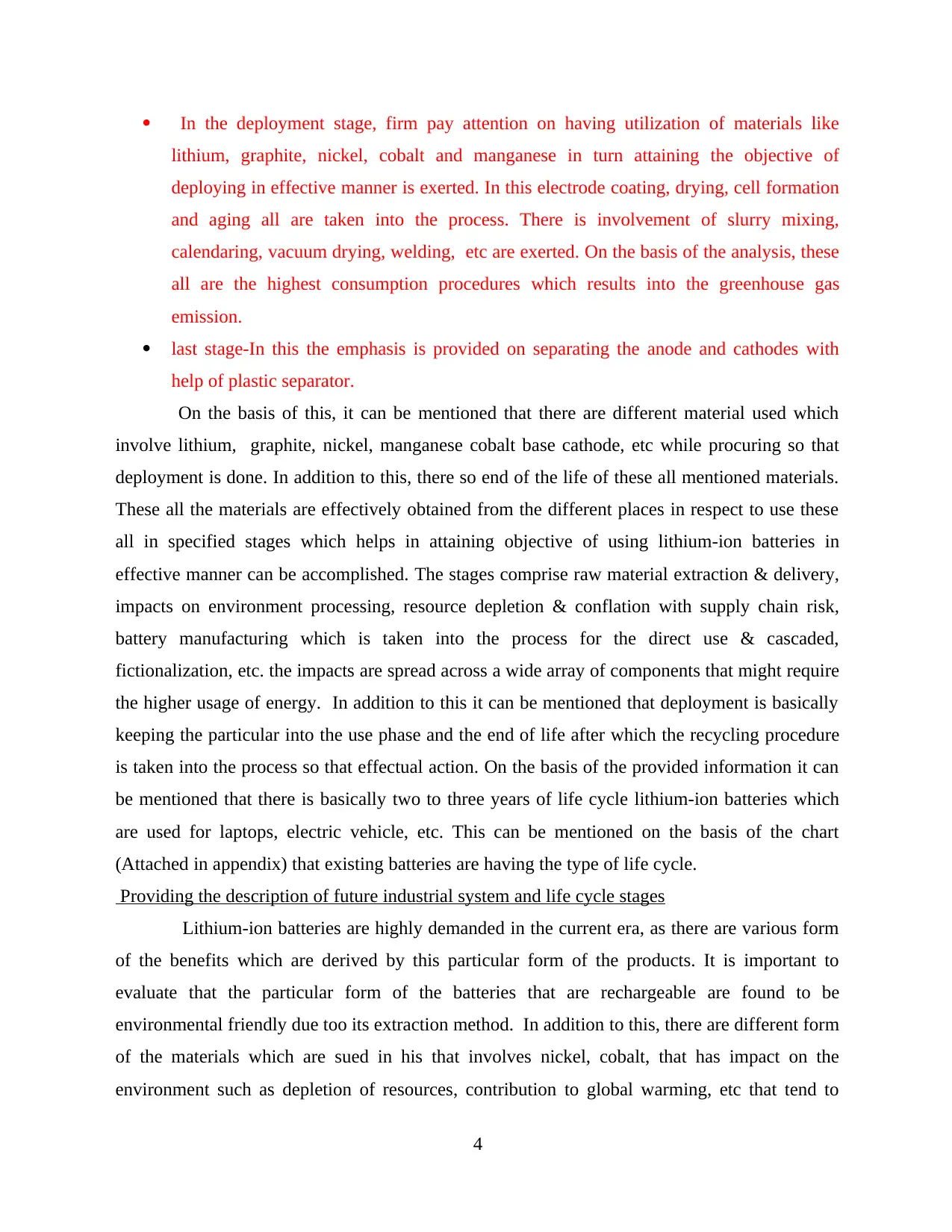
In the deployment stage, firm pay attention on having utilization of materials like
lithium, graphite, nickel, cobalt and manganese in turn attaining the objective of
deploying in effective manner is exerted. In this electrode coating, drying, cell formation
and aging all are taken into the process. There is involvement of slurry mixing,
calendaring, vacuum drying, welding, etc are exerted. On the basis of the analysis, these
all are the highest consumption procedures which results into the greenhouse gas
emission.
last stage-In this the emphasis is provided on separating the anode and cathodes with
help of plastic separator.
On the basis of this, it can be mentioned that there are different material used which
involve lithium, graphite, nickel, manganese cobalt base cathode, etc while procuring so that
deployment is done. In addition to this, there so end of the life of these all mentioned materials.
These all the materials are effectively obtained from the different places in respect to use these
all in specified stages which helps in attaining objective of using lithium-ion batteries in
effective manner can be accomplished. The stages comprise raw material extraction & delivery,
impacts on environment processing, resource depletion & conflation with supply chain risk,
battery manufacturing which is taken into the process for the direct use & cascaded,
fictionalization, etc. the impacts are spread across a wide array of components that might require
the higher usage of energy. In addition to this it can be mentioned that deployment is basically
keeping the particular into the use phase and the end of life after which the recycling procedure
is taken into the process so that effectual action. On the basis of the provided information it can
be mentioned that there is basically two to three years of life cycle lithium-ion batteries which
are used for laptops, electric vehicle, etc. This can be mentioned on the basis of the chart
(Attached in appendix) that existing batteries are having the type of life cycle.
Providing the description of future industrial system and life cycle stages
Lithium-ion batteries are highly demanded in the current era, as there are various form
of the benefits which are derived by this particular form of the products. It is important to
evaluate that the particular form of the batteries that are rechargeable are found to be
environmental friendly due too its extraction method. In addition to this, there are different form
of the materials which are sued in his that involves nickel, cobalt, that has impact on the
environment such as depletion of resources, contribution to global warming, etc that tend to
4
lithium, graphite, nickel, cobalt and manganese in turn attaining the objective of
deploying in effective manner is exerted. In this electrode coating, drying, cell formation
and aging all are taken into the process. There is involvement of slurry mixing,
calendaring, vacuum drying, welding, etc are exerted. On the basis of the analysis, these
all are the highest consumption procedures which results into the greenhouse gas
emission.
last stage-In this the emphasis is provided on separating the anode and cathodes with
help of plastic separator.
On the basis of this, it can be mentioned that there are different material used which
involve lithium, graphite, nickel, manganese cobalt base cathode, etc while procuring so that
deployment is done. In addition to this, there so end of the life of these all mentioned materials.
These all the materials are effectively obtained from the different places in respect to use these
all in specified stages which helps in attaining objective of using lithium-ion batteries in
effective manner can be accomplished. The stages comprise raw material extraction & delivery,
impacts on environment processing, resource depletion & conflation with supply chain risk,
battery manufacturing which is taken into the process for the direct use & cascaded,
fictionalization, etc. the impacts are spread across a wide array of components that might require
the higher usage of energy. In addition to this it can be mentioned that deployment is basically
keeping the particular into the use phase and the end of life after which the recycling procedure
is taken into the process so that effectual action. On the basis of the provided information it can
be mentioned that there is basically two to three years of life cycle lithium-ion batteries which
are used for laptops, electric vehicle, etc. This can be mentioned on the basis of the chart
(Attached in appendix) that existing batteries are having the type of life cycle.
Providing the description of future industrial system and life cycle stages
Lithium-ion batteries are highly demanded in the current era, as there are various form
of the benefits which are derived by this particular form of the products. It is important to
evaluate that the particular form of the batteries that are rechargeable are found to be
environmental friendly due too its extraction method. In addition to this, there are different form
of the materials which are sued in his that involves nickel, cobalt, that has impact on the
environment such as depletion of resources, contribution to global warming, etc that tend to
4
⊘ This is a preview!⊘
Do you want full access?
Subscribe today to unlock all pages.

Trusted by 1+ million students worldwide
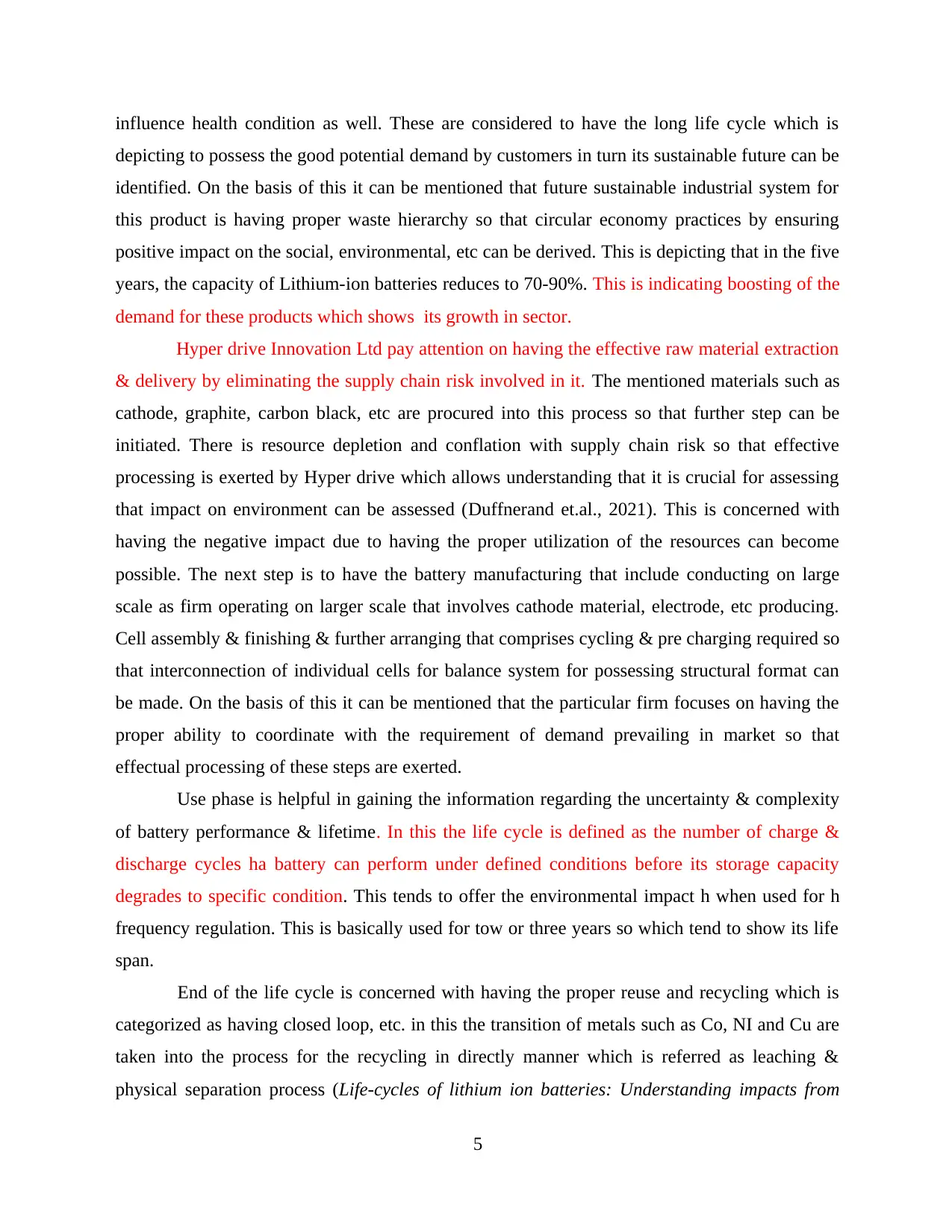
influence health condition as well. These are considered to have the long life cycle which is
depicting to possess the good potential demand by customers in turn its sustainable future can be
identified. On the basis of this it can be mentioned that future sustainable industrial system for
this product is having proper waste hierarchy so that circular economy practices by ensuring
positive impact on the social, environmental, etc can be derived. This is depicting that in the five
years, the capacity of Lithium-ion batteries reduces to 70-90%. This is indicating boosting of the
demand for these products which shows its growth in sector.
Hyper drive Innovation Ltd pay attention on having the effective raw material extraction
& delivery by eliminating the supply chain risk involved in it. The mentioned materials such as
cathode, graphite, carbon black, etc are procured into this process so that further step can be
initiated. There is resource depletion and conflation with supply chain risk so that effective
processing is exerted by Hyper drive which allows understanding that it is crucial for assessing
that impact on environment can be assessed (Duffnerand et.al., 2021). This is concerned with
having the negative impact due to having the proper utilization of the resources can become
possible. The next step is to have the battery manufacturing that include conducting on large
scale as firm operating on larger scale that involves cathode material, electrode, etc producing.
Cell assembly & finishing & further arranging that comprises cycling & pre charging required so
that interconnection of individual cells for balance system for possessing structural format can
be made. On the basis of this it can be mentioned that the particular firm focuses on having the
proper ability to coordinate with the requirement of demand prevailing in market so that
effectual processing of these steps are exerted.
Use phase is helpful in gaining the information regarding the uncertainty & complexity
of battery performance & lifetime. In this the life cycle is defined as the number of charge &
discharge cycles ha battery can perform under defined conditions before its storage capacity
degrades to specific condition. This tends to offer the environmental impact h when used for h
frequency regulation. This is basically used for tow or three years so which tend to show its life
span.
End of the life cycle is concerned with having the proper reuse and recycling which is
categorized as having closed loop, etc. in this the transition of metals such as Co, NI and Cu are
taken into the process for the recycling in directly manner which is referred as leaching &
physical separation process (Life-cycles of lithium ion batteries: Understanding impacts from
5
depicting to possess the good potential demand by customers in turn its sustainable future can be
identified. On the basis of this it can be mentioned that future sustainable industrial system for
this product is having proper waste hierarchy so that circular economy practices by ensuring
positive impact on the social, environmental, etc can be derived. This is depicting that in the five
years, the capacity of Lithium-ion batteries reduces to 70-90%. This is indicating boosting of the
demand for these products which shows its growth in sector.
Hyper drive Innovation Ltd pay attention on having the effective raw material extraction
& delivery by eliminating the supply chain risk involved in it. The mentioned materials such as
cathode, graphite, carbon black, etc are procured into this process so that further step can be
initiated. There is resource depletion and conflation with supply chain risk so that effective
processing is exerted by Hyper drive which allows understanding that it is crucial for assessing
that impact on environment can be assessed (Duffnerand et.al., 2021). This is concerned with
having the negative impact due to having the proper utilization of the resources can become
possible. The next step is to have the battery manufacturing that include conducting on large
scale as firm operating on larger scale that involves cathode material, electrode, etc producing.
Cell assembly & finishing & further arranging that comprises cycling & pre charging required so
that interconnection of individual cells for balance system for possessing structural format can
be made. On the basis of this it can be mentioned that the particular firm focuses on having the
proper ability to coordinate with the requirement of demand prevailing in market so that
effectual processing of these steps are exerted.
Use phase is helpful in gaining the information regarding the uncertainty & complexity
of battery performance & lifetime. In this the life cycle is defined as the number of charge &
discharge cycles ha battery can perform under defined conditions before its storage capacity
degrades to specific condition. This tends to offer the environmental impact h when used for h
frequency regulation. This is basically used for tow or three years so which tend to show its life
span.
End of the life cycle is concerned with having the proper reuse and recycling which is
categorized as having closed loop, etc. in this the transition of metals such as Co, NI and Cu are
taken into the process for the recycling in directly manner which is referred as leaching &
physical separation process (Life-cycles of lithium ion batteries: Understanding impacts from
5
Paraphrase This Document
Need a fresh take? Get an instant paraphrase of this document with our AI Paraphraser
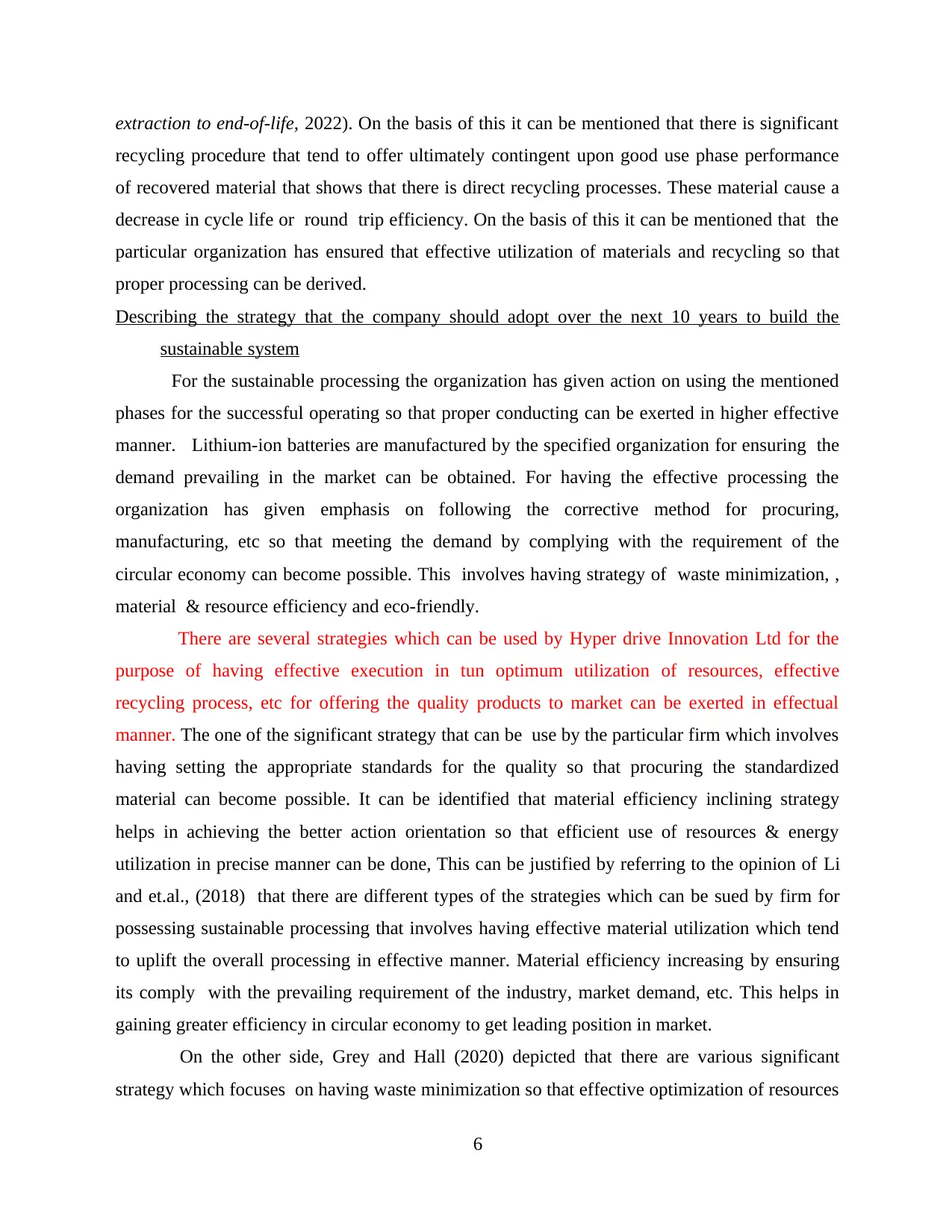
extraction to end-of-life, 2022). On the basis of this it can be mentioned that there is significant
recycling procedure that tend to offer ultimately contingent upon good use phase performance
of recovered material that shows that there is direct recycling processes. These material cause a
decrease in cycle life or round trip efficiency. On the basis of this it can be mentioned that the
particular organization has ensured that effective utilization of materials and recycling so that
proper processing can be derived.
Describing the strategy that the company should adopt over the next 10 years to build the
sustainable system
For the sustainable processing the organization has given action on using the mentioned
phases for the successful operating so that proper conducting can be exerted in higher effective
manner. Lithium-ion batteries are manufactured by the specified organization for ensuring the
demand prevailing in the market can be obtained. For having the effective processing the
organization has given emphasis on following the corrective method for procuring,
manufacturing, etc so that meeting the demand by complying with the requirement of the
circular economy can become possible. This involves having strategy of waste minimization, ,
material & resource efficiency and eco-friendly.
There are several strategies which can be used by Hyper drive Innovation Ltd for the
purpose of having effective execution in tun optimum utilization of resources, effective
recycling process, etc for offering the quality products to market can be exerted in effectual
manner. The one of the significant strategy that can be use by the particular firm which involves
having setting the appropriate standards for the quality so that procuring the standardized
material can become possible. It can be identified that material efficiency inclining strategy
helps in achieving the better action orientation so that efficient use of resources & energy
utilization in precise manner can be done, This can be justified by referring to the opinion of Li
and et.al., (2018) that there are different types of the strategies which can be sued by firm for
possessing sustainable processing that involves having effective material utilization which tend
to uplift the overall processing in effective manner. Material efficiency increasing by ensuring
its comply with the prevailing requirement of the industry, market demand, etc. This helps in
gaining greater efficiency in circular economy to get leading position in market.
On the other side, Grey and Hall (2020) depicted that there are various significant
strategy which focuses on having waste minimization so that effective optimization of resources
6
recycling procedure that tend to offer ultimately contingent upon good use phase performance
of recovered material that shows that there is direct recycling processes. These material cause a
decrease in cycle life or round trip efficiency. On the basis of this it can be mentioned that the
particular organization has ensured that effective utilization of materials and recycling so that
proper processing can be derived.
Describing the strategy that the company should adopt over the next 10 years to build the
sustainable system
For the sustainable processing the organization has given action on using the mentioned
phases for the successful operating so that proper conducting can be exerted in higher effective
manner. Lithium-ion batteries are manufactured by the specified organization for ensuring the
demand prevailing in the market can be obtained. For having the effective processing the
organization has given emphasis on following the corrective method for procuring,
manufacturing, etc so that meeting the demand by complying with the requirement of the
circular economy can become possible. This involves having strategy of waste minimization, ,
material & resource efficiency and eco-friendly.
There are several strategies which can be used by Hyper drive Innovation Ltd for the
purpose of having effective execution in tun optimum utilization of resources, effective
recycling process, etc for offering the quality products to market can be exerted in effectual
manner. The one of the significant strategy that can be use by the particular firm which involves
having setting the appropriate standards for the quality so that procuring the standardized
material can become possible. It can be identified that material efficiency inclining strategy
helps in achieving the better action orientation so that efficient use of resources & energy
utilization in precise manner can be done, This can be justified by referring to the opinion of Li
and et.al., (2018) that there are different types of the strategies which can be sued by firm for
possessing sustainable processing that involves having effective material utilization which tend
to uplift the overall processing in effective manner. Material efficiency increasing by ensuring
its comply with the prevailing requirement of the industry, market demand, etc. This helps in
gaining greater efficiency in circular economy to get leading position in market.
On the other side, Grey and Hall (2020) depicted that there are various significant
strategy which focuses on having waste minimization so that effective optimization of resources
6
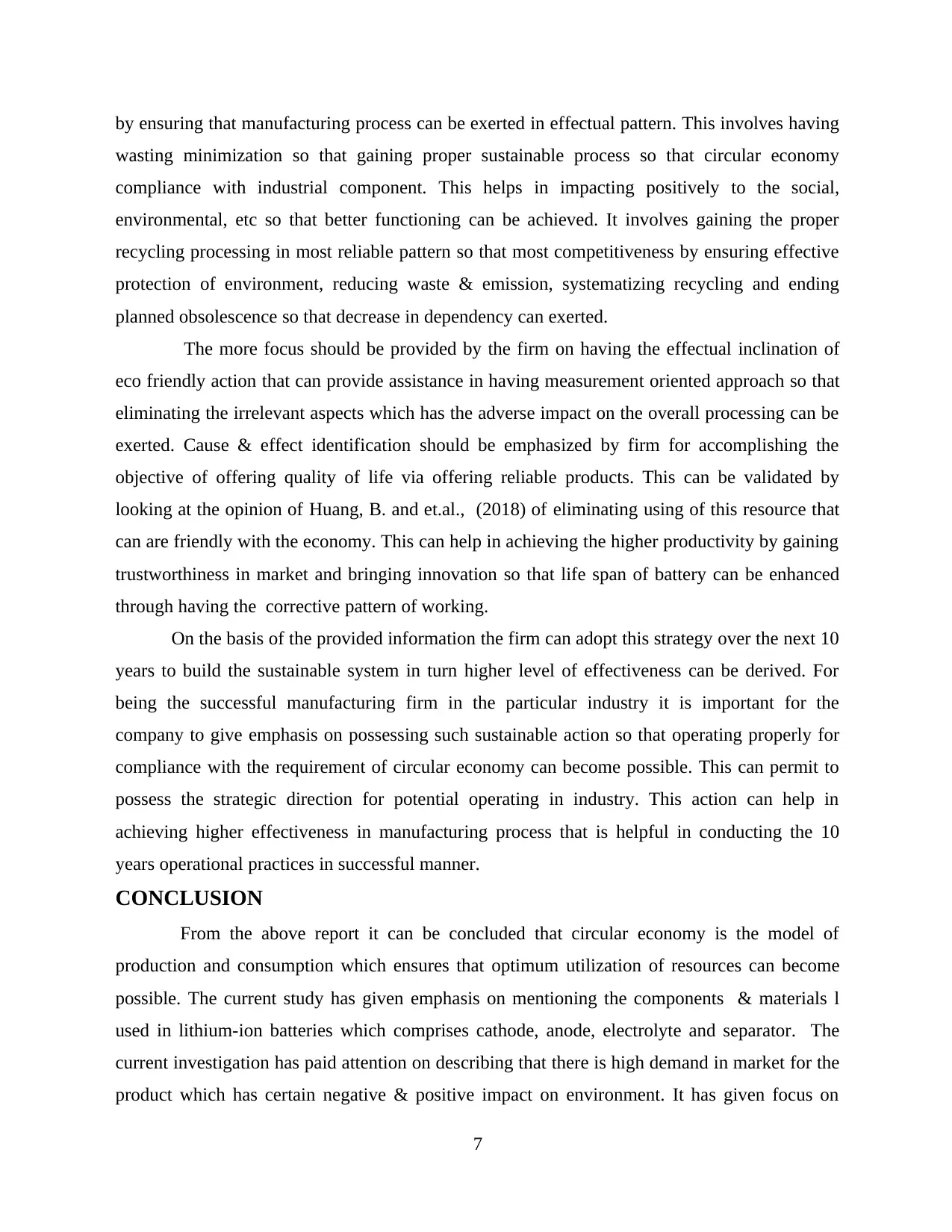
by ensuring that manufacturing process can be exerted in effectual pattern. This involves having
wasting minimization so that gaining proper sustainable process so that circular economy
compliance with industrial component. This helps in impacting positively to the social,
environmental, etc so that better functioning can be achieved. It involves gaining the proper
recycling processing in most reliable pattern so that most competitiveness by ensuring effective
protection of environment, reducing waste & emission, systematizing recycling and ending
planned obsolescence so that decrease in dependency can exerted.
The more focus should be provided by the firm on having the effectual inclination of
eco friendly action that can provide assistance in having measurement oriented approach so that
eliminating the irrelevant aspects which has the adverse impact on the overall processing can be
exerted. Cause & effect identification should be emphasized by firm for accomplishing the
objective of offering quality of life via offering reliable products. This can be validated by
looking at the opinion of Huang, B. and et.al., (2018) of eliminating using of this resource that
can are friendly with the economy. This can help in achieving the higher productivity by gaining
trustworthiness in market and bringing innovation so that life span of battery can be enhanced
through having the corrective pattern of working.
On the basis of the provided information the firm can adopt this strategy over the next 10
years to build the sustainable system in turn higher level of effectiveness can be derived. For
being the successful manufacturing firm in the particular industry it is important for the
company to give emphasis on possessing such sustainable action so that operating properly for
compliance with the requirement of circular economy can become possible. This can permit to
possess the strategic direction for potential operating in industry. This action can help in
achieving higher effectiveness in manufacturing process that is helpful in conducting the 10
years operational practices in successful manner.
CONCLUSION
From the above report it can be concluded that circular economy is the model of
production and consumption which ensures that optimum utilization of resources can become
possible. The current study has given emphasis on mentioning the components & materials l
used in lithium-ion batteries which comprises cathode, anode, electrolyte and separator. The
current investigation has paid attention on describing that there is high demand in market for the
product which has certain negative & positive impact on environment. It has given focus on
7
wasting minimization so that gaining proper sustainable process so that circular economy
compliance with industrial component. This helps in impacting positively to the social,
environmental, etc so that better functioning can be achieved. It involves gaining the proper
recycling processing in most reliable pattern so that most competitiveness by ensuring effective
protection of environment, reducing waste & emission, systematizing recycling and ending
planned obsolescence so that decrease in dependency can exerted.
The more focus should be provided by the firm on having the effectual inclination of
eco friendly action that can provide assistance in having measurement oriented approach so that
eliminating the irrelevant aspects which has the adverse impact on the overall processing can be
exerted. Cause & effect identification should be emphasized by firm for accomplishing the
objective of offering quality of life via offering reliable products. This can be validated by
looking at the opinion of Huang, B. and et.al., (2018) of eliminating using of this resource that
can are friendly with the economy. This can help in achieving the higher productivity by gaining
trustworthiness in market and bringing innovation so that life span of battery can be enhanced
through having the corrective pattern of working.
On the basis of the provided information the firm can adopt this strategy over the next 10
years to build the sustainable system in turn higher level of effectiveness can be derived. For
being the successful manufacturing firm in the particular industry it is important for the
company to give emphasis on possessing such sustainable action so that operating properly for
compliance with the requirement of circular economy can become possible. This can permit to
possess the strategic direction for potential operating in industry. This action can help in
achieving higher effectiveness in manufacturing process that is helpful in conducting the 10
years operational practices in successful manner.
CONCLUSION
From the above report it can be concluded that circular economy is the model of
production and consumption which ensures that optimum utilization of resources can become
possible. The current study has given emphasis on mentioning the components & materials l
used in lithium-ion batteries which comprises cathode, anode, electrolyte and separator. The
current investigation has paid attention on describing that there is high demand in market for the
product which has certain negative & positive impact on environment. It has given focus on
7
⊘ This is a preview!⊘
Do you want full access?
Subscribe today to unlock all pages.

Trusted by 1+ million students worldwide
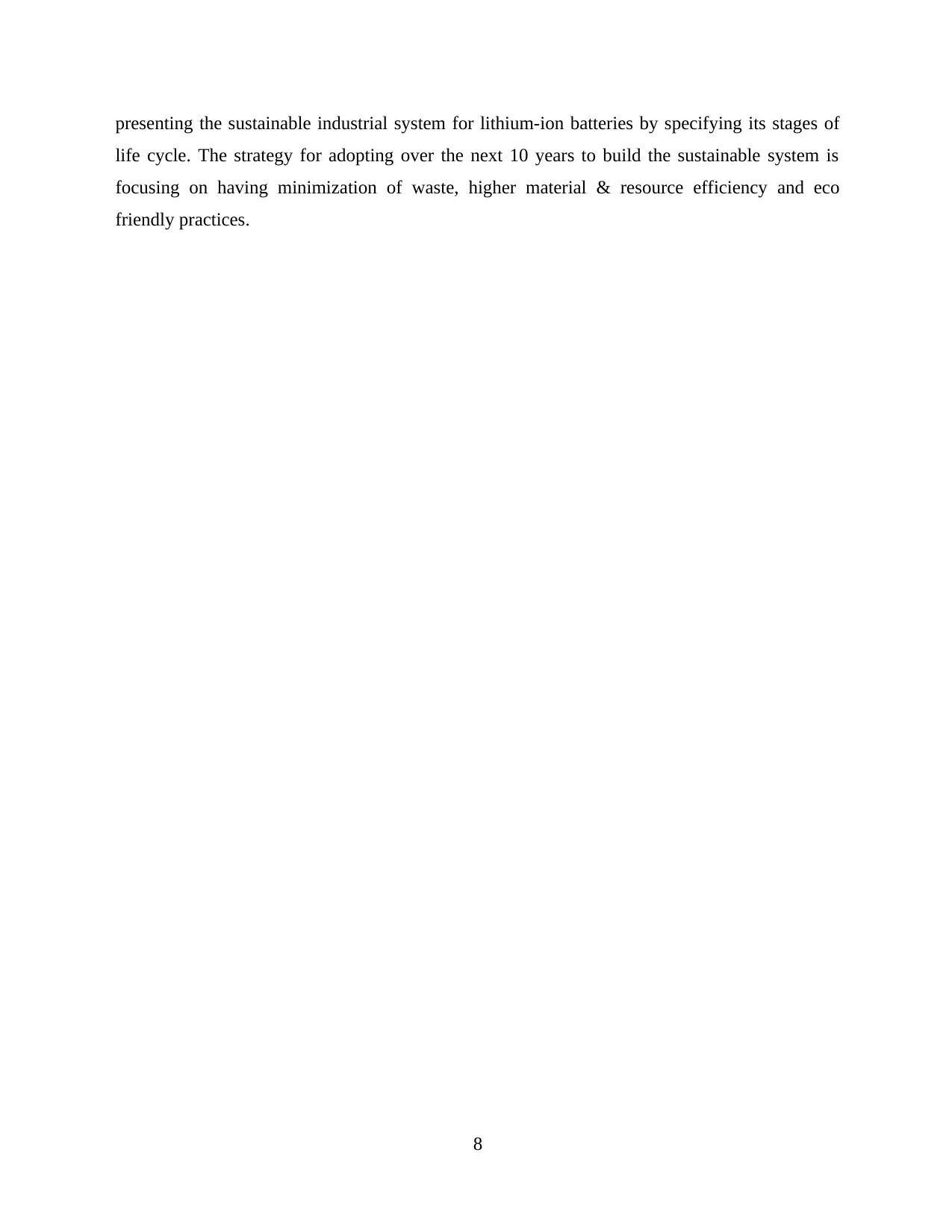
presenting the sustainable industrial system for lithium-ion batteries by specifying its stages of
life cycle. The strategy for adopting over the next 10 years to build the sustainable system is
focusing on having minimization of waste, higher material & resource efficiency and eco
friendly practices.
8
life cycle. The strategy for adopting over the next 10 years to build the sustainable system is
focusing on having minimization of waste, higher material & resource efficiency and eco
friendly practices.
8
Paraphrase This Document
Need a fresh take? Get an instant paraphrase of this document with our AI Paraphraser
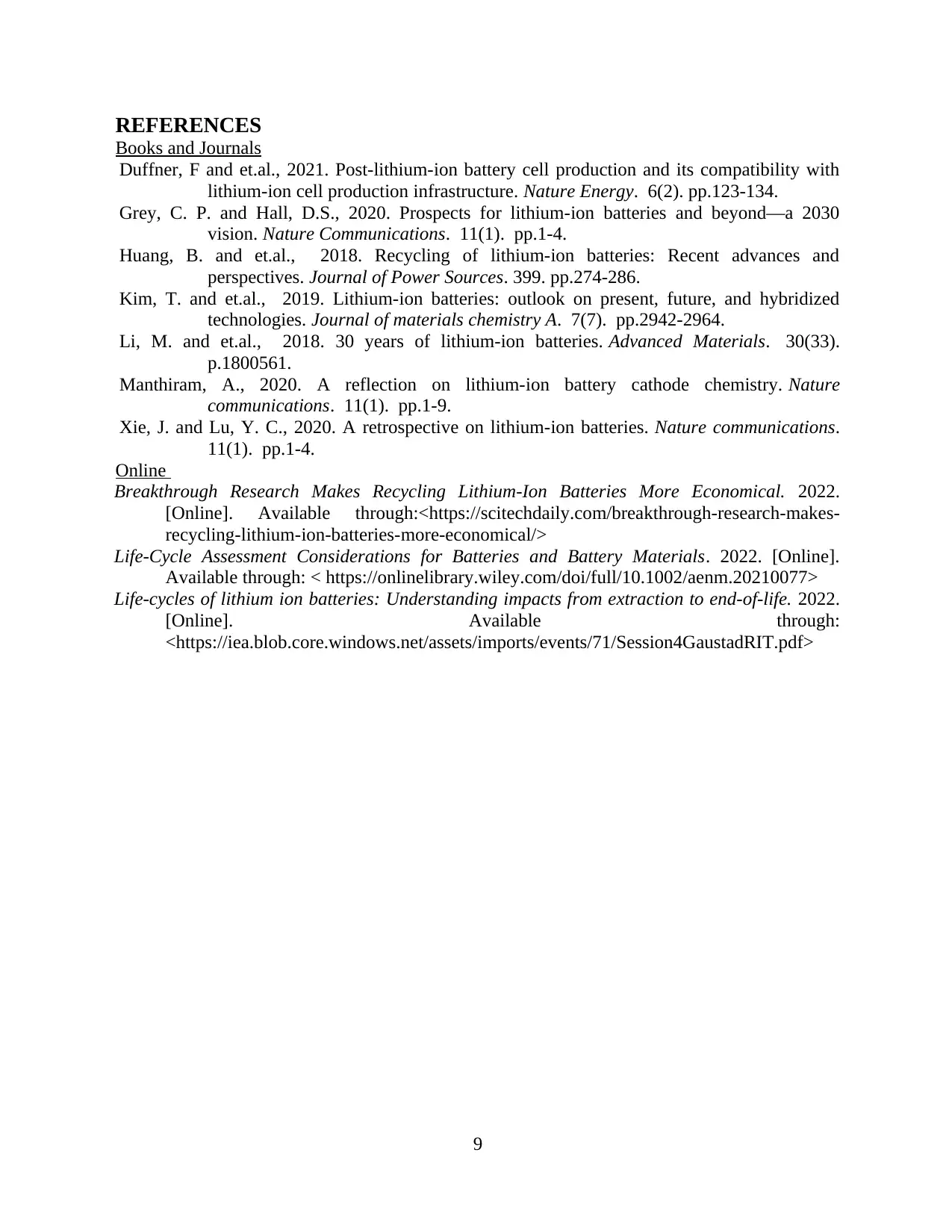
REFERENCES
Books and Journals
Duffner, F and et.al., 2021. Post-lithium-ion battery cell production and its compatibility with
lithium-ion cell production infrastructure. Nature Energy. 6(2). pp.123-134.
Grey, C. P. and Hall, D.S., 2020. Prospects for lithium-ion batteries and beyond—a 2030
vision. Nature Communications. 11(1). pp.1-4.
Huang, B. and et.al., 2018. Recycling of lithium-ion batteries: Recent advances and
perspectives. Journal of Power Sources. 399. pp.274-286.
Kim, T. and et.al., 2019. Lithium-ion batteries: outlook on present, future, and hybridized
technologies. Journal of materials chemistry A. 7(7). pp.2942-2964.
Li, M. and et.al., 2018. 30 years of lithium‐ion batteries. Advanced Materials. 30(33).
p.1800561.
Manthiram, A., 2020. A reflection on lithium-ion battery cathode chemistry. Nature
communications. 11(1). pp.1-9.
Xie, J. and Lu, Y. C., 2020. A retrospective on lithium-ion batteries. Nature communications.
11(1). pp.1-4.
Online
Breakthrough Research Makes Recycling Lithium-Ion Batteries More Economical. 2022.
[Online]. Available through:<https://scitechdaily.com/breakthrough-research-makes-
recycling-lithium-ion-batteries-more-economical/>
Life-Cycle Assessment Considerations for Batteries and Battery Materials. 2022. [Online].
Available through: < https://onlinelibrary.wiley.com/doi/full/10.1002/aenm.20210077>
Life-cycles of lithium ion batteries: Understanding impacts from extraction to end-of-life. 2022.
[Online]. Available through:
<https://iea.blob.core.windows.net/assets/imports/events/71/Session4GaustadRIT.pdf>
9
Books and Journals
Duffner, F and et.al., 2021. Post-lithium-ion battery cell production and its compatibility with
lithium-ion cell production infrastructure. Nature Energy. 6(2). pp.123-134.
Grey, C. P. and Hall, D.S., 2020. Prospects for lithium-ion batteries and beyond—a 2030
vision. Nature Communications. 11(1). pp.1-4.
Huang, B. and et.al., 2018. Recycling of lithium-ion batteries: Recent advances and
perspectives. Journal of Power Sources. 399. pp.274-286.
Kim, T. and et.al., 2019. Lithium-ion batteries: outlook on present, future, and hybridized
technologies. Journal of materials chemistry A. 7(7). pp.2942-2964.
Li, M. and et.al., 2018. 30 years of lithium‐ion batteries. Advanced Materials. 30(33).
p.1800561.
Manthiram, A., 2020. A reflection on lithium-ion battery cathode chemistry. Nature
communications. 11(1). pp.1-9.
Xie, J. and Lu, Y. C., 2020. A retrospective on lithium-ion batteries. Nature communications.
11(1). pp.1-4.
Online
Breakthrough Research Makes Recycling Lithium-Ion Batteries More Economical. 2022.
[Online]. Available through:<https://scitechdaily.com/breakthrough-research-makes-
recycling-lithium-ion-batteries-more-economical/>
Life-Cycle Assessment Considerations for Batteries and Battery Materials. 2022. [Online].
Available through: < https://onlinelibrary.wiley.com/doi/full/10.1002/aenm.20210077>
Life-cycles of lithium ion batteries: Understanding impacts from extraction to end-of-life. 2022.
[Online]. Available through:
<https://iea.blob.core.windows.net/assets/imports/events/71/Session4GaustadRIT.pdf>
9
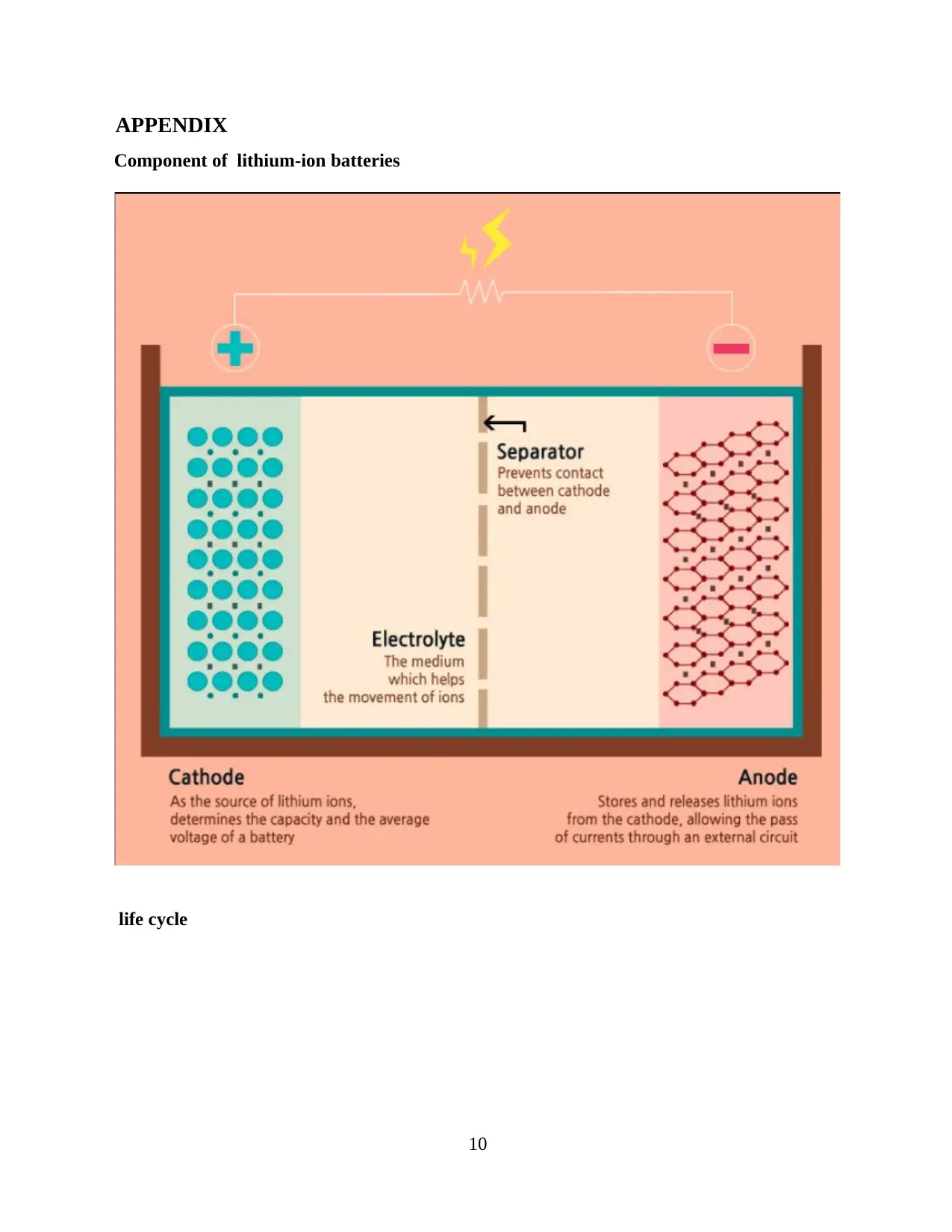
APPENDIX
Component of lithium-ion batteries
life cycle
10
Component of lithium-ion batteries
life cycle
10
⊘ This is a preview!⊘
Do you want full access?
Subscribe today to unlock all pages.

Trusted by 1+ million students worldwide
1 out of 13
Related Documents
Your All-in-One AI-Powered Toolkit for Academic Success.
+13062052269
info@desklib.com
Available 24*7 on WhatsApp / Email
![[object Object]](/_next/static/media/star-bottom.7253800d.svg)
Unlock your academic potential
Copyright © 2020–2025 A2Z Services. All Rights Reserved. Developed and managed by ZUCOL.





